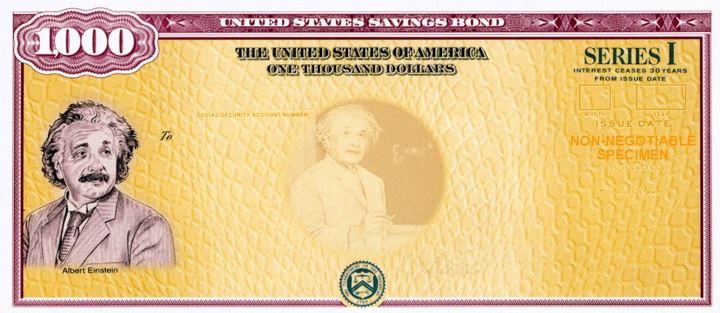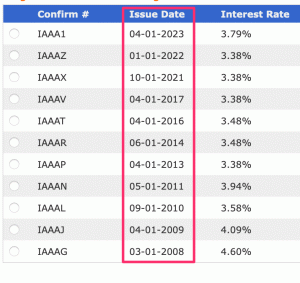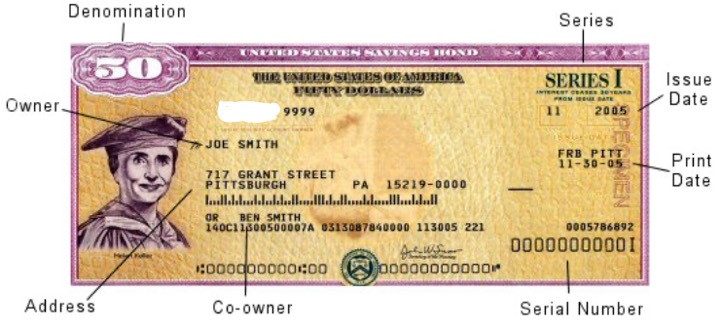
After the November 2023 fixed rate was announced to be higher at 1.3%, I’ve gotten a few questions about redeeming “old” Savings I Bonds with lower fixed rates (some at 0%) and buying these “new” ones instead. During this current 6-month period, a lot of them are also earning less than a 4% interest rate when you add the ~3.38% inflation rate. Here are some considerations in making that decision:
When was the fixed rate very low? The fixed rates on your Savings I Bonds were set based on the month of purchase (issue). You can find a list of fixed rates based on issue date here and here. With a few exceptions, look for fixed rates between 0% and 0.30% which occurred with issue dates between May 2008 and October 2018, and again between November 2019 and October 2022.

Find the issue date of your specific savings bonds at TreasuryDirect.gov or on the face of your paper bond.


3-month interest penalty for savings bonds held less than 5 years. So you’ve found the ones with very low fixed rates. But also remember, if you redeem before 5 years, you lose the final 3 months of interest completely. Your actual interest rate changes every 6 months, and so you can time which 3 months of interest you lose. You may want any period of high inflation to “run out” before you redeem.
Here are redemption dates if you want to time it such that the 3 months interest rate penalty you lose is the only first 3 months of the lower 3.38% inflation rate (which first started in May 2023). Some of the dates have passed, and the window is already open. I first saw this reported by TIPSWatch.
- Issue month: November/May 👉 Redeem after August 1st, 2023
- Issue month: December/June 👉 Redeem after September 1st, 2023
- Issue month: January/July 👉 Redeem after October 1st, 2023
- Issue month: February/August 👉 Redeem after November 1st, 2023
- Issue month: March/September 👉 Redeem after December 1st, 2023
- Issue month: April/October 👉 Redeem after January 1st, 2024
Annual purchase limits. Savings I Bonds have purchase limits of $10,000 per year per SSN (plus another $5,000 via tax return and other ownership title “loopholes”). So if you sell your past existing holdings, you can’t necessarily turn around and buy double or triple your usual amount this year at the higher fixed rate. If aren’t coming close to exceeding the purchase limits, then this is not a concern, and selling savings bonds at 0% fixed rate and buying at 1.3% fixed rate may be a simple and smart move.
Alternatively, you may wish to sell your 0% fixed rate bonds and purchase individual TIPS of a specific maturity instead due to the current higher real yields. I Bonds and TIPS have both similarities and important differences, one of which is that you can never lose money (nominally) with a savings bond, but your long-term TIPS may drop by 10% or more in the short-term.
Tax deferral. Savings bonds have a unique feature that you can defer paying any taxes until you redeem them (or until they mature after 30 years). If you redeem your savings bonds now, you will have to pay any taxes on all of the accumulated interest this tax year. The tax deferral and thus tax-free compounding can increase your overall return if you don’t have other tax-deferred space available. In addition, if your marginal tax rate is very high right now, but you expect it to be much lower in the near future (perhaps in retirement), then you may wish to wait a bit.
My overall take? As you can see, there are lots of little details and exceptions, but… If you’re using savings bonds as a short-term cash reserve or otherwise have another good place for the money, then it’s probably best to sell your 0% fixed rate bonds and re-invest in alternatives.
However, if you’ve been building up a big pile for long-term inflation protection combined with flexibility with taxes and withdrawals, and you are just buying up to the limits every year already, and don’t have other pressing needs for that money, then I don’t feel you’ll be hurt horribly by holding.
Personally, I’ll probably be selling most if not all of my 0% fixed rate bonds over time, with sensitivity to my overall tax brackets. I plan to reinvest into long-term TIPS at 2%+ fixed real rates as tax-deferred space is available.
 The Best Credit Card Bonus Offers – 2025
The Best Credit Card Bonus Offers – 2025 Big List of Free Stocks from Brokerage Apps
Big List of Free Stocks from Brokerage Apps Best Interest Rates on Cash - 2025
Best Interest Rates on Cash - 2025 Free Credit Scores x 3 + Free Credit Monitoring
Free Credit Scores x 3 + Free Credit Monitoring Best No Fee 0% APR Balance Transfer Offers
Best No Fee 0% APR Balance Transfer Offers Little-Known Cellular Data Plans That Can Save Big Money
Little-Known Cellular Data Plans That Can Save Big Money How To Haggle Your Cable or Direct TV Bill
How To Haggle Your Cable or Direct TV Bill Big List of Free Consumer Data Reports (Credit, Rent, Work)
Big List of Free Consumer Data Reports (Credit, Rent, Work)
Interesting post, I’ve been considering this for a while. There is no doubt I could get a better rate especially with treasuries. But, I have to take a tax hit along with other securities I might sell. It’s just one big math problem.
I’ve been hoping someone would make a magical calculator to do the math on this for me.
How do I redeem old paper bonds from the 90’s? Most banks won’t do it anymore…
You can mail it in to TreasuryDirect with a form, or you can convert to electronic form there as well (to hold or redeem later), if you can’t find a bank or credit union in-person.
Thanks for this posting Jonathan. My $50K was purchased from 2020-2023. I was able to double dip in 2022 because I created a trust account.
With the exception of 2023 purchase (3.79%) all are yielding 3.38%. I am thinking of selling after January 2024 my holding from 2022 and then buy in January $10K to get the 1.3% fixed rate.
Since my first purchase was in 2020, if I wait until 2025 to sell I won’t incur any penalties.
Your thoughts would be appreciated?
Hi Jonathan,
I would appreciate your input on my last comment. If I cash in an I bond that was purchased in 2022 and sale after 1/2024 I will loose 3.38% for 3 months? Correct?
Yes, you’ll lose the last 3 months of interest if cashed in earlier than 5 years.
Thanks! I appreciate your blog and all you do for us self-directed retail investors!
I’ve been a long time reader and subscriber of your blog. Thank you for all of the things you have alerted me to over the years.
I am considering selling my I-bonds and repurchasing TIPS. Are you more inclined to purchase the TIPS via open market through a brokerage account (Vanguard, Fidelity, etc.) or as new issues via Treasury Direct? Is there an advantage to purchasing one way versus the other?
If I understand correctly, all interest on I-Bonds is tax deferred and automatically reinvested in the original security, while interest on TIPS is treated as income the year it is paid and is not reinvested in the original security. Is this correct?
Adirondackjack, are you thinking a TIP fund. I made a big mistake with purchasing Vanguard’s TIP fund and got hit with a big tax bill last year. The fund had a big end of year tax distribution. I subsequently learned my lesson, TIPS obviously belong in a tax deferred account.
Joanne,
Interest (and inflation adjustments that increase the principal) from an individually owned TIPs bond is taxable each year when it is paid. The TIPS fund may have distributed additional capital gains beyond these two items due to sales of bonds above the fund’s cost basis.
I have 30,000 in I bonds purchased in 2021in addition to the same amount purchased every year since. The 2021 bonds have a zero fixed rate. I would like to withdraw the 30,000 in 2021 bonds and leave the interest in the accounts and use the 30,000 in original bond edemption to to use to buy 30,000 in 2024 and gain the 1.3 fixed rate. I would like to do this to avoid any tax on the interest left n their respective accounts.
I have been unable to get an answer on the best way to facilitate the swap.
Thank you
Jim